Christina Harward
Ukrainian forces carried out drone and cruise missile strikes on occupied Crimea and significantly damaged the Russian Black Sea Fleet (BSF) Command headquarters in Sevastopol on September 22. The Ukrainian Armed Forces Center for Strategic Communications (StratCom) stated that Ukrainian forces launched a successful strike on the Russian BSF Command headquarters in Sevastopol, Crimea on September 22.[1] Russian sources claimed that Ukrainian forces used Storm Shadow cruise missiles to conduct the strike, and social media footage of the headquarters indicates significant damage to the building.[2] The Russian Ministry of Defense (MoD) claimed that Russian air defenses shot down five Ukrainian missiles and acknowledged that the Ukrainian strike damaged a building of BSF Command headquarters.[3] Russian sources claimed that Ukrainian forces launched a drone strike preceding the missile strike, and the Russian MoD claimed that Russian air defenses shot down two Ukrainian drones on the western coast of Crimea on the morning of September 22.[4]
Ukrainian Air Force Commander Lieutenant General Mykola Oleshchuk thanked Ukrainian pilots in general when amplifying footage of the strike.[5] Ukrainian Southern Operational Command Spokesperson Captain First Rank Nataliya Humenyuk stated that Ukrainian forces will strike more Russian military targets in Crimea in the future.[6] Ukrainian National Security and Defense Council Secretary Oleksiy Danilov stated that Ukrainian forces will continue to strike Sevastopol and that the Russian BSF should destroy their own ships in order to avoid further Ukrainian strikes.[7]
The Russian information space heavily focused its attention on the Ukrainian strike on Sevastopol on September 22. One Russian milblogger complained about Russian authorities’ inability to control the spread of Ukrainian information about the consequences of the strike, and other milbloggers criticized Russian authorities and the Russian military for not retaliating sufficiently.[8] Another Russian milblogger claimed that such Ukrainian strikes on Crimea are expected as Ukraine and its Western partners consider Crimea to be Ukrainian territory.[9] Multiple Russian milbloggers claimed that Western partners helped Ukrainian forces target the BSF Command headquarters.[10]
Ukrainian forces advanced south of Bakhmut and reportedly advanced in western Zaporizhia Oblast on September 22. Geolocated footage published on September 22 indicates that Ukrainian forces advanced southeast of Klishchiivka (7km southwest of Bakhmut).[11] A Kremlin-affiliated milblogger claimed that Ukrainian forces slightly advanced north of Novoprokopivka and are currently about 800 meters away from the settlement’s outskirts, a claim that generally corresponds to ISW’s assessment of the closest approach of the Ukrainian counter-offensive to the settlement.[12] The Ukrainian General Staff reported that Ukrainian forces continued to conduct offensive operations in the Melitopol (western Zaporizhia Oblast) direction and offensive actions in the Bakhmut direction, exhausting and inflicting losses on Russian forces along the entire front.[13]
The US Department of Defense (DoD) announced a new security assistance package on September 21, providing Ukraine with $325 million worth of military equipment.[14] The DoD package includes AIM-9M missiles for air defense; additional ammunition for HIMARS systems; Avenger air defense systems; anti-drone machine guns; 155mm and 105mm artillery rounds, including dual-purpose improved conventional munitions (DPICM); Tube-Launched, Optically-Tracked, Wire-Guided (TOW) missiles; Javelin and AT-4 anti-armor systems; over three million rounds of small arms ammunition; light tactical vehicles; demolition munitions for obstacle clearing; and spare parts, maintenance equipment, and other field equipment.
The US will reportedly soon provide long-range army tactical missile systems (ATACMS) to Ukraine. Four unnamed US government officials told NBC News in an article published on September 22 that US President Joe Biden told Ukrainian President Volodymyr Zelensky that the US would provide Ukraine with “a small number of long-range missiles.”[15] The officials did not state when the US would announce the provision of ATACMS or when the US would deliver them to Ukraine.[16] One US official told NBC News that US officials are still discussing the type of missile and the number of missiles the US would provide to Ukraine.[17] Several unnamed people familiar with ongoing deliberations on ATACMS also told the Washington Post that the Biden administration plans to provide Ukraine with a version of ATACMS armed with cluster bomblets rather than a single (unitary) warhead.[18] The Washington Post reported that cluster-armed ATACMS have a range of up to 190 miles (depending on the version) and could allow Ukraine to strike Russian military positions far into the rear.
Russian efforts to intensify divisions between Ukraine and its Central European partners appear to have suffered a setback as Polish President Andrzej Duda reiterated the strength of Polish-Ukrainian relations on September 22. Duda clarified Polish Prime Minister Mateusz Morwiecki’s September 21 statement that Poland would no longer transfer weapons to Ukraine and explained that Poland would continue to fulfill weapons supplies agreements with Ukraine but would not transfer new weapons that Poland purchases for its own military.[19] Duda also stated that the potential conflict between the two countries regarding the export of Ukrainian grain along European land routes does not “significantly affect” the two countries’ relationship.[20] ISW has previously assessed that Russian strikes on Ukrainian port and grain infrastructure are part of a Russian campaign to damage Ukrainian relations with its Western neighbors, and Poland’s swift reiteration of its commitment to Ukraine indicates that this campaign is not succeeding as much as Moscow likely intends.[21]
A Ukrainian military official swiftly denied Russian claims that Wagner Group forces are operating in occupied Kherson Oblast. Several Russian sources claimed on September 22 that Wagner personnel arrived in combat areas in occupied Kherson Oblast and that assault troops are distributed across sectors of the Kherson Oblast frontline.[22] Ukrainian Southern Operational Command Spokesperson Captain First Rank Nataliya Humenyuk denied this claim on September 22 and stated that Russian sources likely disseminate such claims in order to improve Russian morale.[23] Humenyuk also stated that Chechen forces and Rosgvardia (Russian National Guard) forces arrived in occupied Kherson ”a few weeks ago” in order to prevent Russian military personnel from deserting.[24] Russian milbloggers may be claiming that Wagner forces have arrived in occupied Kherson Oblast amid rumors that Wagner forces will return to hostilities in Ukraine operating alongside Rosgvardia.[25]
The Russian Federal Security Service (FSB) is reportedly investigating high-ranking Rosgvardia officials over their potential involvement in Wagner Group’s rebellion on June 24. A Russian insider source claimed on September 22 that the FSB is investigating Rosgvardia officials after Rosgvardia reportedly allowed Wagner to “hide” shells and equipment in Rosgvardia’s warehouses immediately after the Wagner rebellion and during the period of Wagner’s disarmament.[26] The source claimed that an unspecified Rosgvardia general with the first name “Roman” oversaw the storage of up to four large containers of Wagner military equipment near a Rosgvardia training ground in the area of “Kazachy Stan” (likely a settlement in an unspecified region of Russia).[27] ISW continues to assess that the Kremlin likely aimed to consolidate Russia‘s internal security apparatus around Rosgvardia following the Wagner rebellion.[28] The Russian Ministry of Defense (MoD) announced on June 27 that it would prepare to transfer Wagner’s heavy military equipment to unspecified elements of the Russian military on the same day that Rosgvardia Head Viktor Zolotov announced that Rosgvardia would receive heavy weapons and tanks.[29] The Russian government also officially transferred the “Grom” special units of the Russian Federal Drug Control Service (of the Russian Ministry of Internal Affairs) to the control of Rosgvardia in July.[30]
Key Takeaways:
- Ukrainian forces carried out drone and cruise missile strikes on occupied Crimea and significantly damaged the Russian Black Sea Fleet (BSF) Command headquarters in Sevastopol on September 22.
- The Russian information space heavily focused its attention on the Ukrainian strike on Sevastopol on September 22.
- Ukrainian forces advanced south of Bakhmut and reportedly advanced in western Zaporizhia Oblast on September 22.
- The US Department of Defense (DoD) announced a new security assistance package on September 21, providing Ukraine with $325 million worth of military equipment.
- The US will reportedly soon provide long-range army tactical missile systems (ATACMS) to Ukraine.
- Russian efforts to intensify divisions between Ukraine and its Central European partners appear to have suffered a setback as Polish President Andrzej Duda reiterated the strength of Polish-Ukrainian relations on September 22.
- A Ukrainian military official swiftly denied Russian claims that Wagner Group forces are operating in occupied Kherson Oblast.
- The Russian Federal Security Service (FSB) is reportedly investigating high-ranking Rosgvardia officials over their potential involvement in Wagner Group’s rebellion on June 24.
- Russian forces conducted offensive operations in the Kupyansk area, near Bakhmut, along the Avdiivka-Donetsk City line, and in western Donetsk Oblast and reportedly advanced in the Donetsk-Zaporizhia Oblast administrative border area.
- The Russian government is reportedly planning to increase defense spending by 4.4 trillion rubles ($46 billion) in 2024.
We do not report in detail on Russian war crimes because these activities are well-covered in Western media and do not directly affect the military operations we are assessing and forecasting. We will continue to evaluate and report on the effects of these criminal activities on the Ukrainian military and the Ukrainian population and specifically on combat in Ukrainian urban areas. We utterly condemn these Russian violations of the laws of armed conflict, Geneva Conventions, and humanity even though we do not describe them in these reports.
- Russian Main Effort – Eastern Ukraine (comprised of two subordinate main efforts)
- Russian Subordinate Main Effort #1 – Capture the remainder of Luhansk Oblast and push westward into eastern Kharkiv Oblast and encircle northern Donetsk Oblast
- Russian Subordinate Main Effort #2 – Capture the entirety of Donetsk Oblast
- Russian Supporting Effort – Southern Axis
- Russian Mobilization and Force Generation Efforts
- Activities in Russian-occupied areas
Russian Main Effort – Eastern Ukraine
Russian Subordinate Main Effort #1 – Luhansk Oblast (Russian objective: Capture the remainder of Luhansk Oblast and push westward into eastern Kharkiv Oblast and northern Donetsk Oblast)
Russian forces reportedly conducted offensive operations in the Kupyansk area on September 22 but did not advance. A Russian milblogger claimed that Russian forces are counterattacking in an unspecified area in the Kupyansk direction.[31] Ukrainian Severodonetsk City Administration Head Roman Vlasenko stated on September 22 that Russian forces are more actively using artillery and aviation in operations in Luhansk Oblast in order to save manpower and equipment.[32] A milblogger also noted that Russian Aerospace Forces (VKS) have increased their operations over the past week in an attempt to strike Ukrainian forward positions and logistics.[33]
Russian sources claimed that Ukrainian forces conducted unsuccessful offensive operations along the Svatove-Kreminna line on September 22. The Russian Ministry of Defense (MoD) claimed that Russian forces repelled Ukrainian attacks near Hryhorivka (11km south of Kreminna) and the Serebryanske forest area (11km south of Kreminna).[34] A Russian milblogger claimed that Ukrainian forces are conducting small and unsuccessful attacks near Novoselivske (14km northwest of Svatove).[35] Another Russian milblogger retracted his September 21 claim that Ukrainian forces regained previously lost positions in Novoselivske and claimed that Ukrainian forces actually conducted counterattacks in Novoyehorivka (16km southwest of Svatove).[36]
Russian Subordinate Main Effort #2 – Donetsk Oblast (Russian objective: Capture the entirety of Donetsk Oblast, the claimed territory of Russia’s proxies in Donbas)
Ukrainian forces continued assaults near Bakhmut on September 22 and advanced. Geolocated footage published on September 22 indicates that Ukrainian forces advanced southeast of Klishchiivka (7km southwest of Bakhmut).[37] A Russian milblogger claimed that Ukrainian forces advanced near Andriivka (10km southwest of Bakhmut) and that Russian forces established defensive positions along the railway near the settlement.[38] The Ukrainian General Staff reported that Ukrainian forces continued assaults south of Bakhmut, inflicting losses on Russian manpower and equipment and consolidating newly secured positions.[39]
Russian forces continued ground attacks near Bakhmut on September 22 but did not make any confirmed advances. The Ukrainian General Staff reported that Russian forces conducted unsuccessful attacks near Mynkivka (13km northeast of Bakhmut), Orikhovo-Vasylivka (11km northwest of Bakhmut), Hryhorivka (9km northwest of Bakhmut), and Andriivka.[40] Ukrainian Eastern Group of Forces Spokesperson Captain Ilya Yevlash and Russian milbloggers stated that Russian forces unsuccessfully counterattacked near Klishchiivka and Andriivka.[41] A Russian milblogger claimed that neither Russian nor Ukrainian forces control these settlements, contrary to the visual evidence that ISW has observed. [42]Another Russian milblogger claimed on September 21 that the situation is very difficult for Russian forces along the Klishchiivka-Kurdyumivka (7-12km southwest of Bakhmut) line, particularly near Andriivka.[43] The milblogger claimed that Russian forces will not have enough manpower to defend against future Ukrainian attacks in this area unless they stop their “ill-conceived and unsupported” counterattacks.[44] Another Russian milblogger amplified footage on September 22 claiming to show elements of the Russian 57th Separate Guards Motorized Rifle Brigade (5th Combined Arms Army, Eastern Military District) and Chechen Akhmat Spetsnaz operating near Kurdyumivka (12km southwest of Bakhmut).[45]
Ukrainian forces continued ground attacks along the Avdiivka-Donetsk City line on September 22 but did not make any confirmed advances. The Ukrainian General Staff reported that Ukrainian forces continued to defend against Russian attacks and inflicted losses against Russian manpower and equipment in the Avdiivka direction.[46] The Russian Ministry of Defense (MoD) claimed that elements of the Russian Southern Grouping of Forces repelled four Ukrainian attacks near Vodiane (on the northwestern outskirts of Donetsk City) and Marinka (directly southwest of Donetsk City).[47]
Russian forces continued ground attacks along the Avdiivka-Donetsk City line on September 22 but did not make any confirmed advances. The Ukrainian General Staff reported that Russian forces conducted unsuccessful attacks near Sieverne (6km west of Avdiivka), Krasnohorivka (directly west of Donetsk City), and Marinka.[48] A Russian milblogger also claimed that Russian forces assaulted Sieverne and Marinka but did not specify an outcome.[49] Another Russian milblogger claimed that Russian forces recaptured another Trudovske mine ventilation shaft just south of Krasnohorivka, although ISW has not observed visual confirmation of this claim.[50]
Russian Supporting Effort – Southern Axis (Russian objective: Maintain frontline positions and secure rear areas against Ukrainian strikes)
Russian forces continued launching unsuccessful localized attacks in western Donetsk Oblast and preparing defensive positions near Mariupol on September 22. The Ukrainian General Staff reported that Ukrainian forces repelled Russian attacks near Mykilske (5km southeast of Vuhledar).[51] Ukrainian Mariupol Mayoral Advisor Petro Andryushchenko reported that Russian forces transported “dragons teeth” fortifications equipment in the direction of Nikolske (16km northwest of Mariupol) to build a defensive line in the area that would defend Russia’s ground lines of communication (GLOCs) towards occupied Crimea.[52] Andryushchenko also reported that Ukrainian forces struck an unspecified Russian target in Rozivka (44km northwest of Mariupol).[53]
Ukrainian forces continued localized attacks on the administrative border between Donetsk and Zaporizhia oblasts but were reportedly unsuccessful on September 22. A Russian news aggregator claimed that Ukrainian forces unsuccessfully attacked near Pryyutne (14km southwest of Velyka Novosilka).[54] The Russian ”Vostok” Battalion claimed that the situation in the Donetsk-Zaporizhia Oblast administrative border is stable and that Ukrainian forces are not attempting to advance, however.[55]
Russian sources claimed that Russian forces achieved limited territorial gains in the Donetsk-Zaporizhia Oblast administrative border area on September 22, but ISW has not observed visual evidence confirming these claims. Zaporizhia Oblast occupation official Vladimir Rogov claimed on September 22 that Russian forces repelled a Ukrainian attack near Zavitne Bazhannya (11km south of Velyka Novosilka), advanced along the Mokri Yaly River valley, and seized unspecified Ukrainian positions.[56] A Kremlin-affiliated milblogger claimed that Russian forces carried out successful counterattacks from Novodonetske (12km southeast of Velyka Novosilka) and Novomayorske (18km southeast of Velyka Novosilka).[57] Another Russian milblogger claimed that Russian forces cleared an unspecified area between Novodonetske and Novomayorske of Ukrainian forces.[58]
Ukrainian forces continued offensive operations in western Zaporizhia Oblast on September 22 and reportedly advanced north of Novoprokopivka (14km south of Orikhiv).[59] A Kremlin-affiliated milblogger claimed that Ukrainian forces slightly advanced north of Novoprokopivka and are currently about 800 meters away from the settlement’s outskirts – an observation consistent with ISW’s control-of-terrain maps.[60] The milblogger added that Ukrainian forces unsuccessfully attempted to advance near Verbove (18km south of Orikhiv). The Ukrainian General Staff reported that Ukrainian forces are continuing offensive operations in the Melitopol direction, are inflicting manpower and equipment losses on Russian forces, and are forcing Russian forces to withdraw from their positions.[61] A Kremlin-affiliated milblogger claimed that Ukrainian forces have not broken through the “Surovikin” defense line west of Verbove and claimed that Ukrainian forces have not achieved any visible successes in the area in a month.[62]
Russian forces continued to counterattack in western Zaporizhia Oblast on September 22, but did not make new territorial gains. The Ukrainian General Staff reported that Ukrainian forces repelled Russian assaults near Mala Tokmachka (7km southeast of Orikhiv) and Robotyne (10km south of Orikhiv).[63] A Russian milblogger claimed that both sides are heavily using artillery and drones in western Zaporizhia Oblast.[64]
Russian sources continued to claim that Ukrainian forces are conducting cross-river raids in the Dnipro River delta. A Russian milblogger claimed that Ukrainian forces still hold positions near Dachi (10km south of Kherson City) and near the Antonivsky Bridge on the east (left) bank Kherson Oblast.[65] A Kremlin-affiliated milblogger claimed that Ukrainian sabotage and reconnaissance groups operated on several islands in the delta on September 22.[66] Russian milbloggers also reamplified complaints that Russian forces lack high-speed boats to repel Ukrainian operations in the delta.[67]
Russian Mobilization and Force Generation Efforts (Russian objective: Expand combat power without conducting general mobilization)
The Russian government is reportedly planning to increase defense spending by 4.4 trillion rubles ($46 billion) in 2024. Bloomberg reported on September 22 that draft plans of the Russian 2024 budget indicate that Russian defense spending will increase to 10.8 trillion rubles (about $113 billion) in 2024, up from 6.4 trillion rubles (about $67 billion) in 2023.[68] Bloomberg reported that Russia plans to spend six percent of its projected gross domestic product (GDP) on defense in 2024, compared to 3.9 percent in 2023 and 2.7 percent in 2021.[69] Bloomberg reported that classified expenditures will also rise from 6.5 trillion rubles (about $68 billion) in 2023 to 11.1 trillion rubles (about $116 billion) in 2024.[70] Bloomberg reported that the Russian government expects state revenues to increase by 22 percent in 2024 and the state deficit to decrease by 50 percent, although it is unclear how likely this outcome is considering international sanctions against Russia and the high cost of the war in Ukraine.[71]
The Russian State Duma is considering extending additional laws related to the Russian Ministry of Defense (MoD) to the Russian National Guard (Rosgvardia). Russian State Duma deputies, including Chairperson of the State Duma Committee on Information Policy Alexander Khinshtein and Chairperson of the State Duma Committee on Defense Andrei Kartapolov, introduced a bill to the Duma that would extend the law on punishing those who “discredit” and spread “fake” information about the Russian armed forces to Rosgvardia forces as well.[72] ISW previously reported that the Duma is also reportedly considering legislation that would extend Russian MoD powers and mechanisms to include volunteer formations to Rosgvardia.[73] ISW also previously reported on speculation that the Wagner Group personnel are working closely with Rosgvardia in order to rejoin the war in Ukraine.[74]
Russian authorities are expanding drone development facilities in Russia. The Deputy Prime Minister of the Republic of Tatarstan Roman Shaikhutdinov announced on September 22 that the Innopolis Special Economic Zone and Innopolis University have entered an agreement with the Unmanned Aircraft Systems LLC to test the drone companies’ products in Tatarstan.[75] ISW previously reported on Russian efforts to expand domestic drone development and production throughout Russia and assessed that the Russian military command may be using a large number of strike drones in Ukraine in order to overwhelm Ukrainian air defenses.[76]
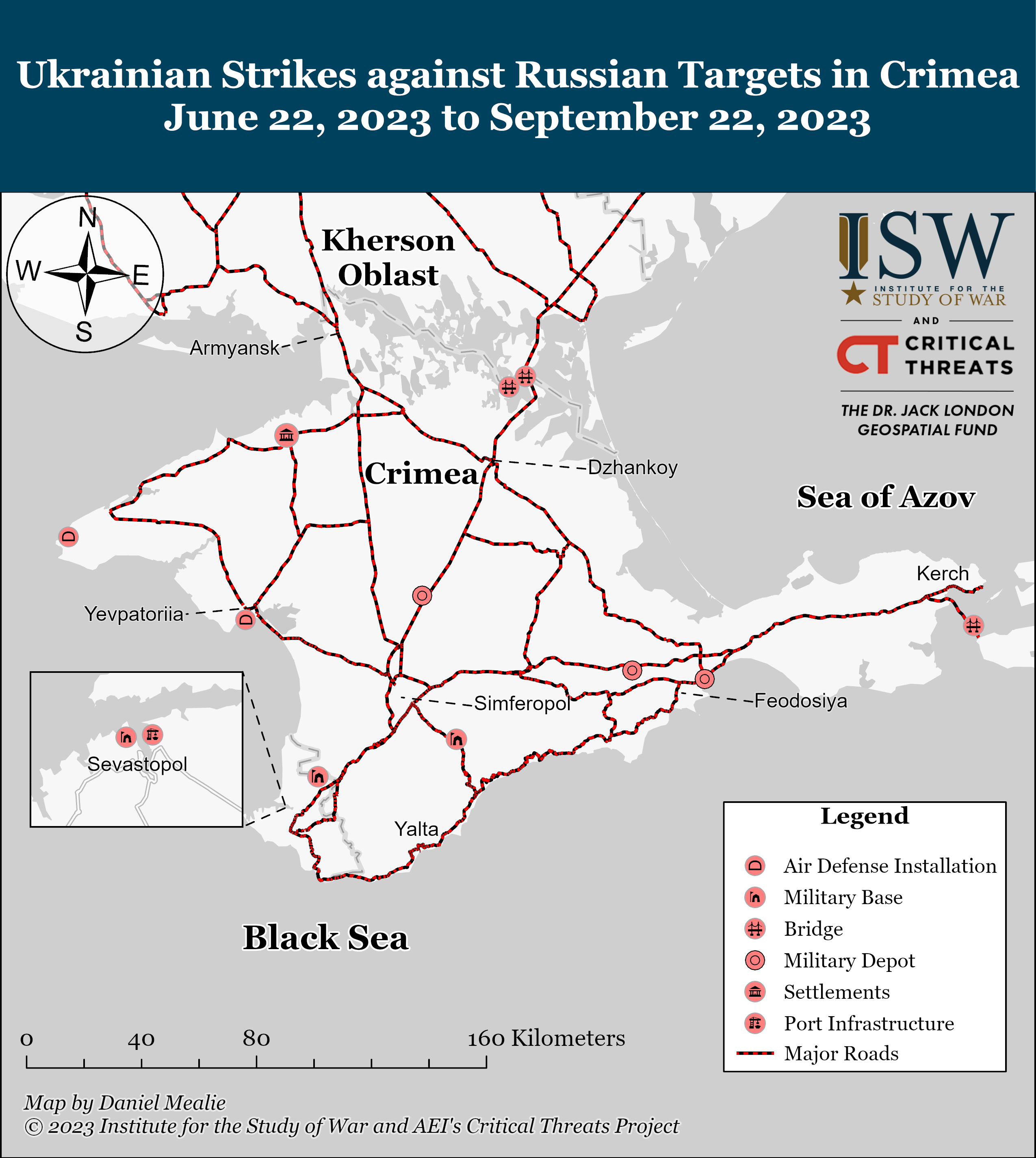
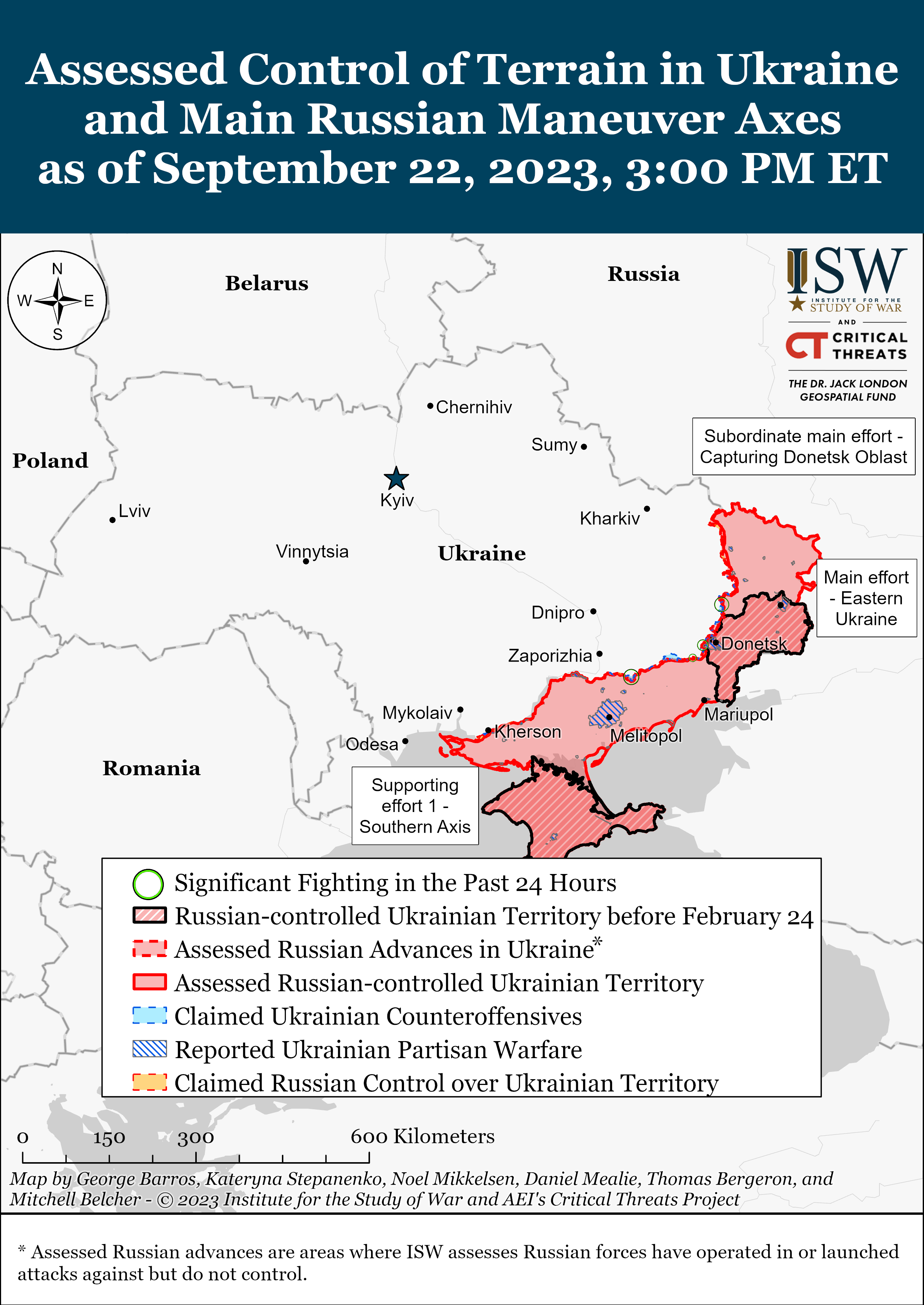
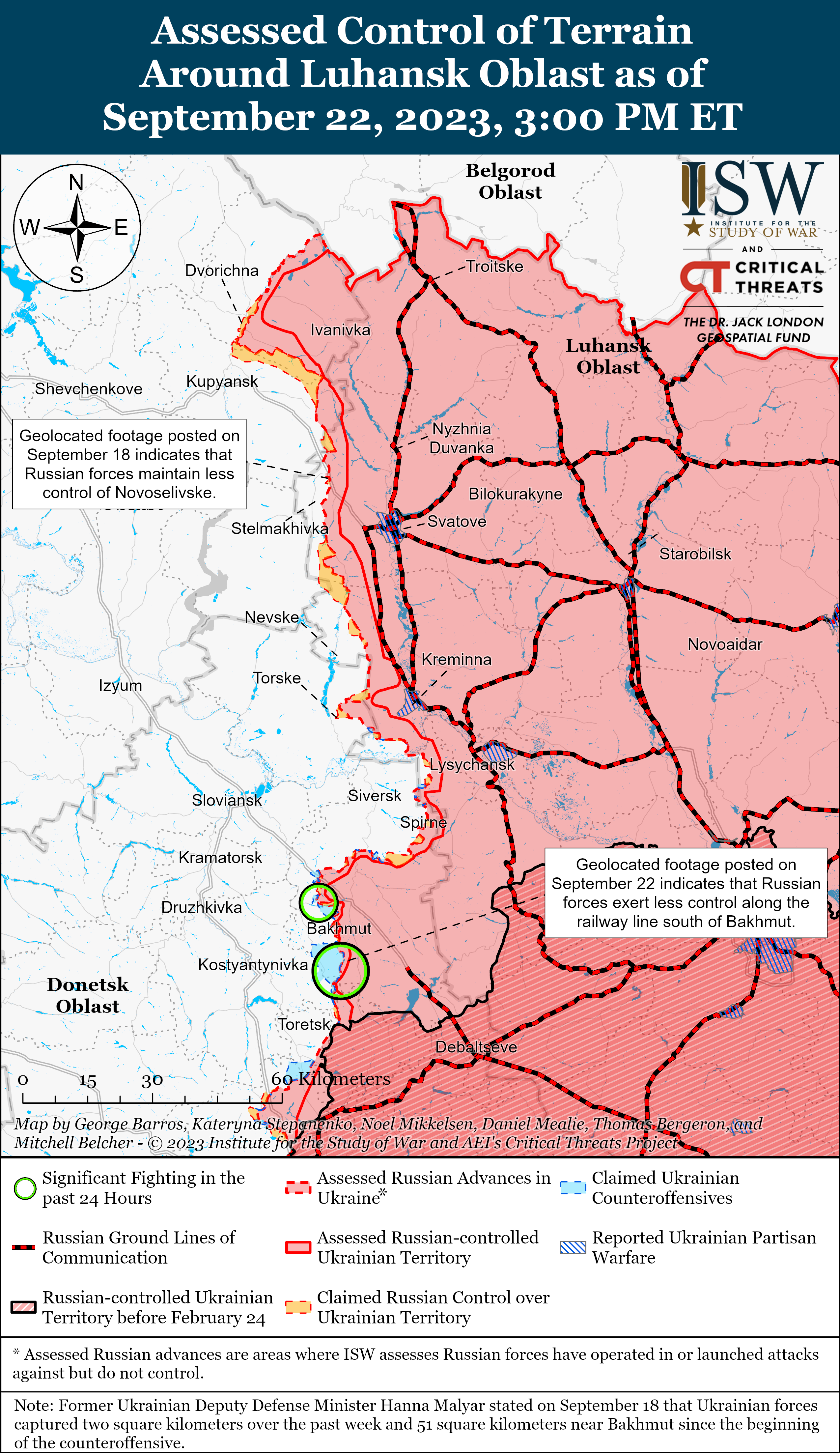
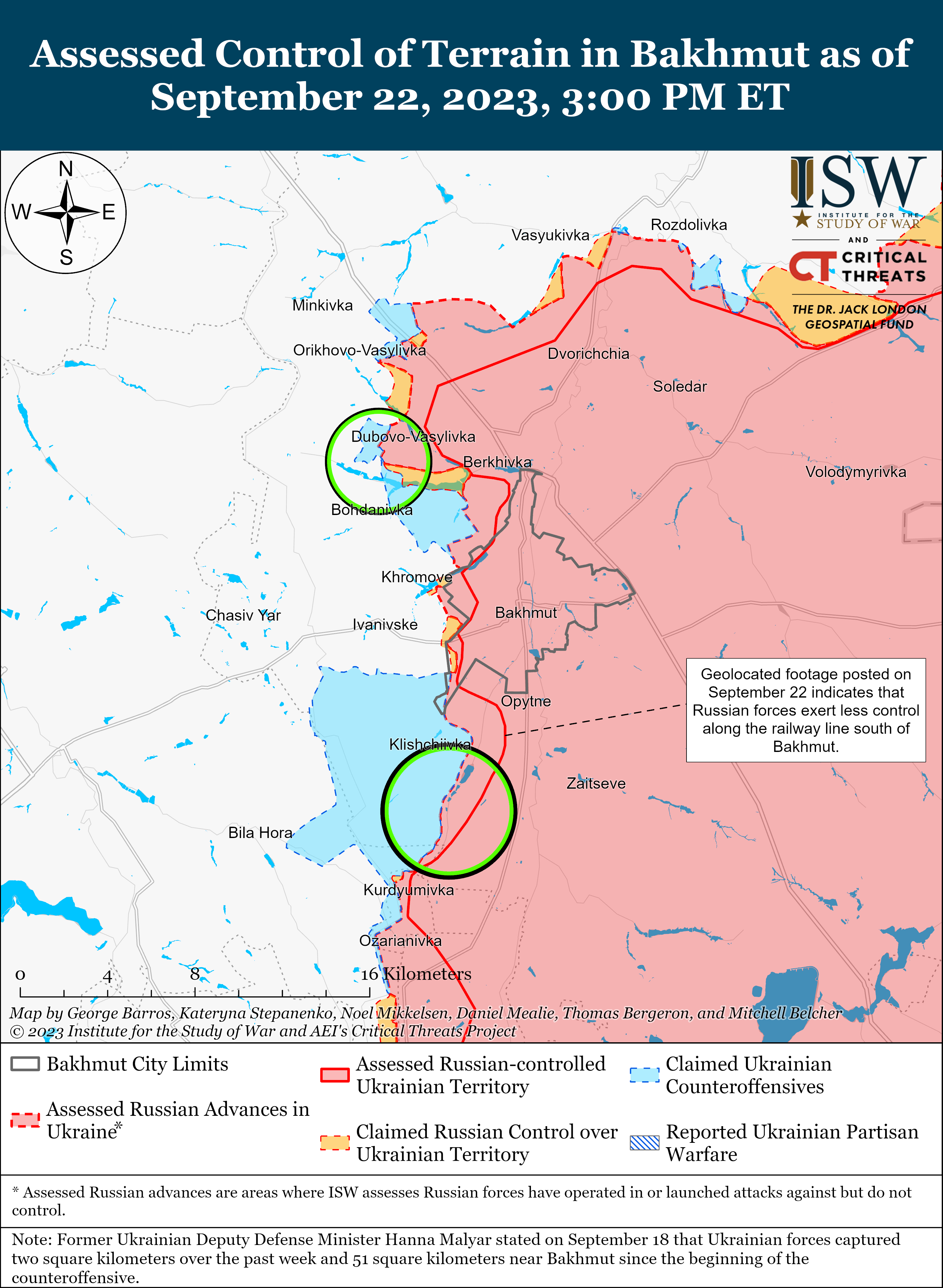
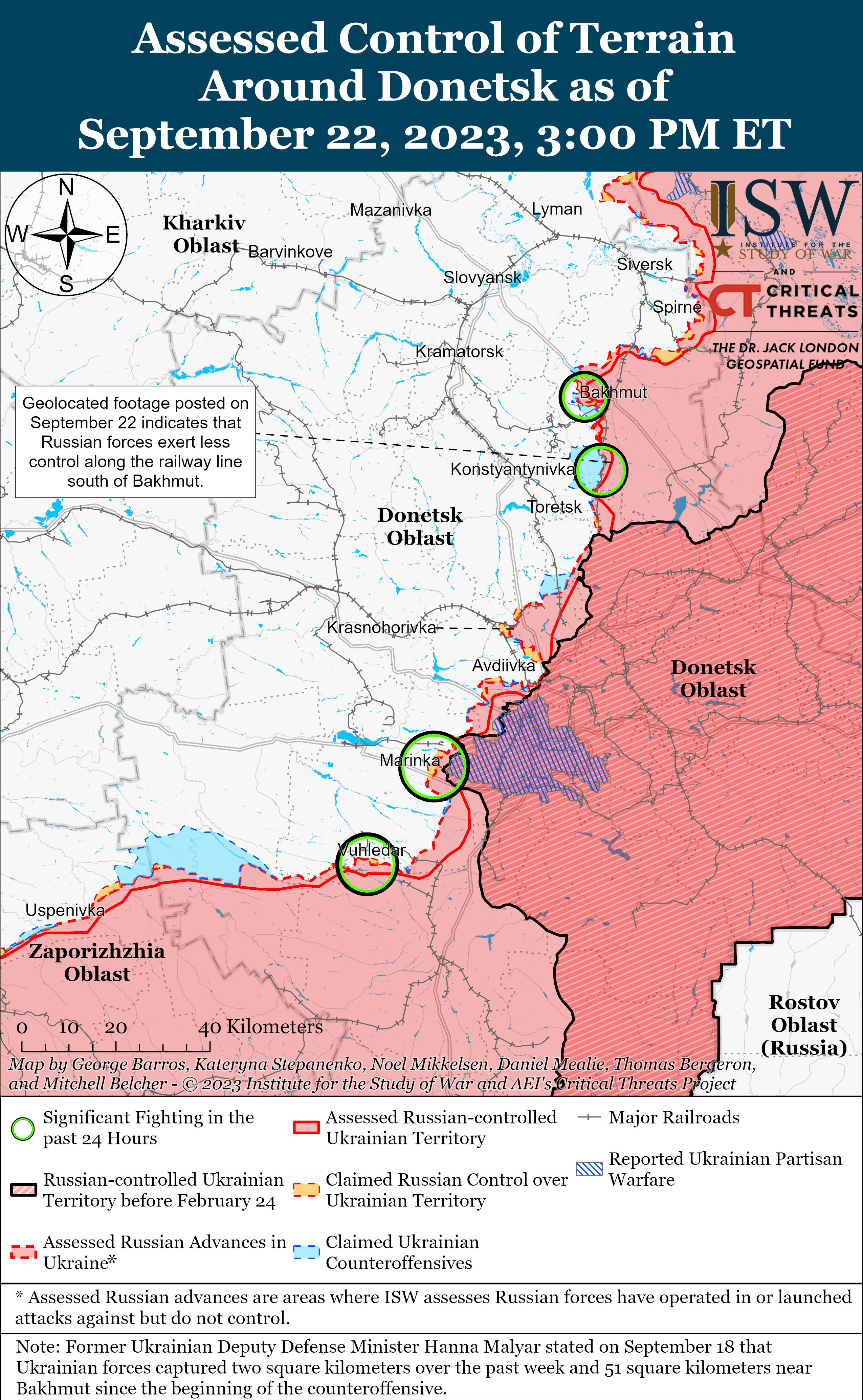
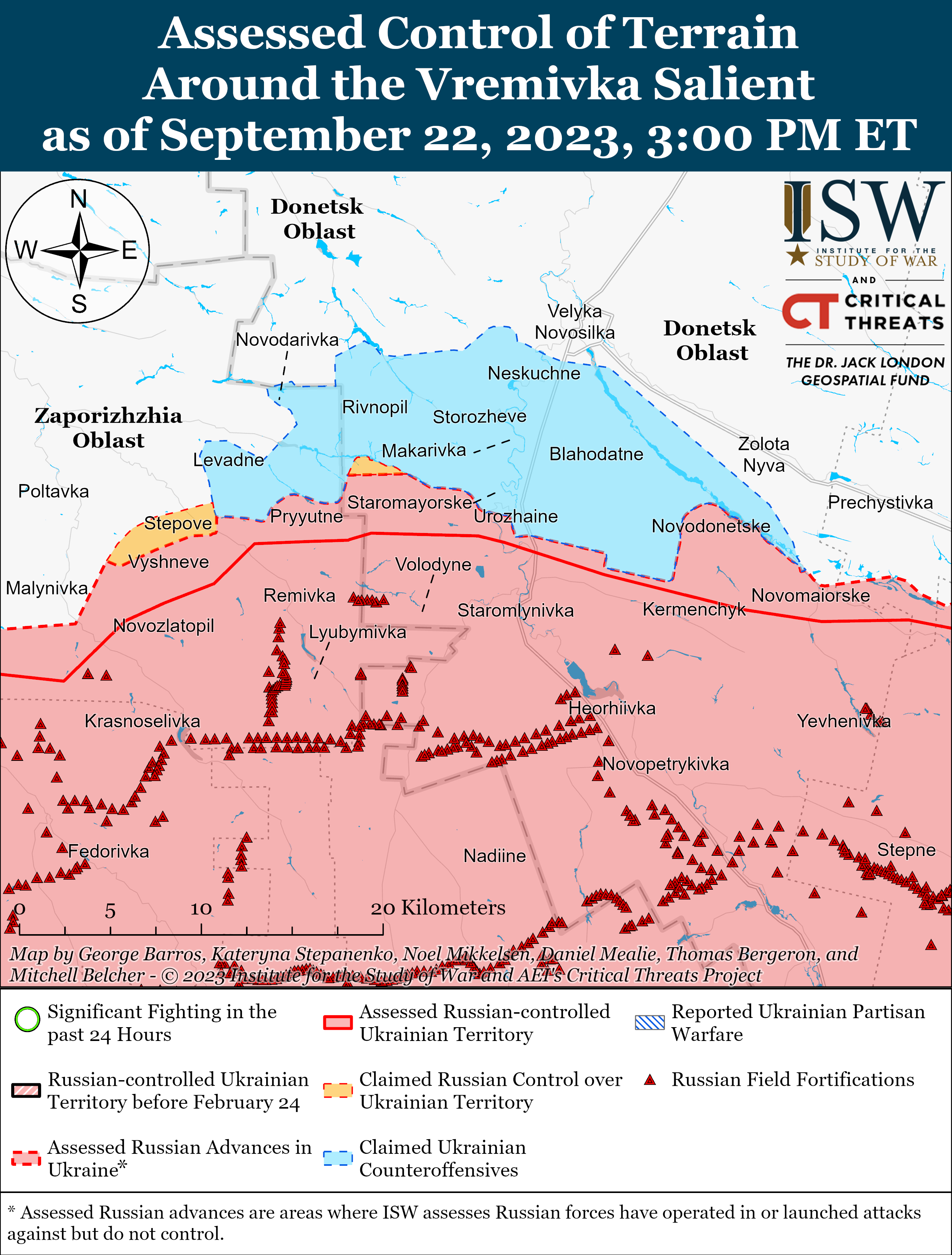
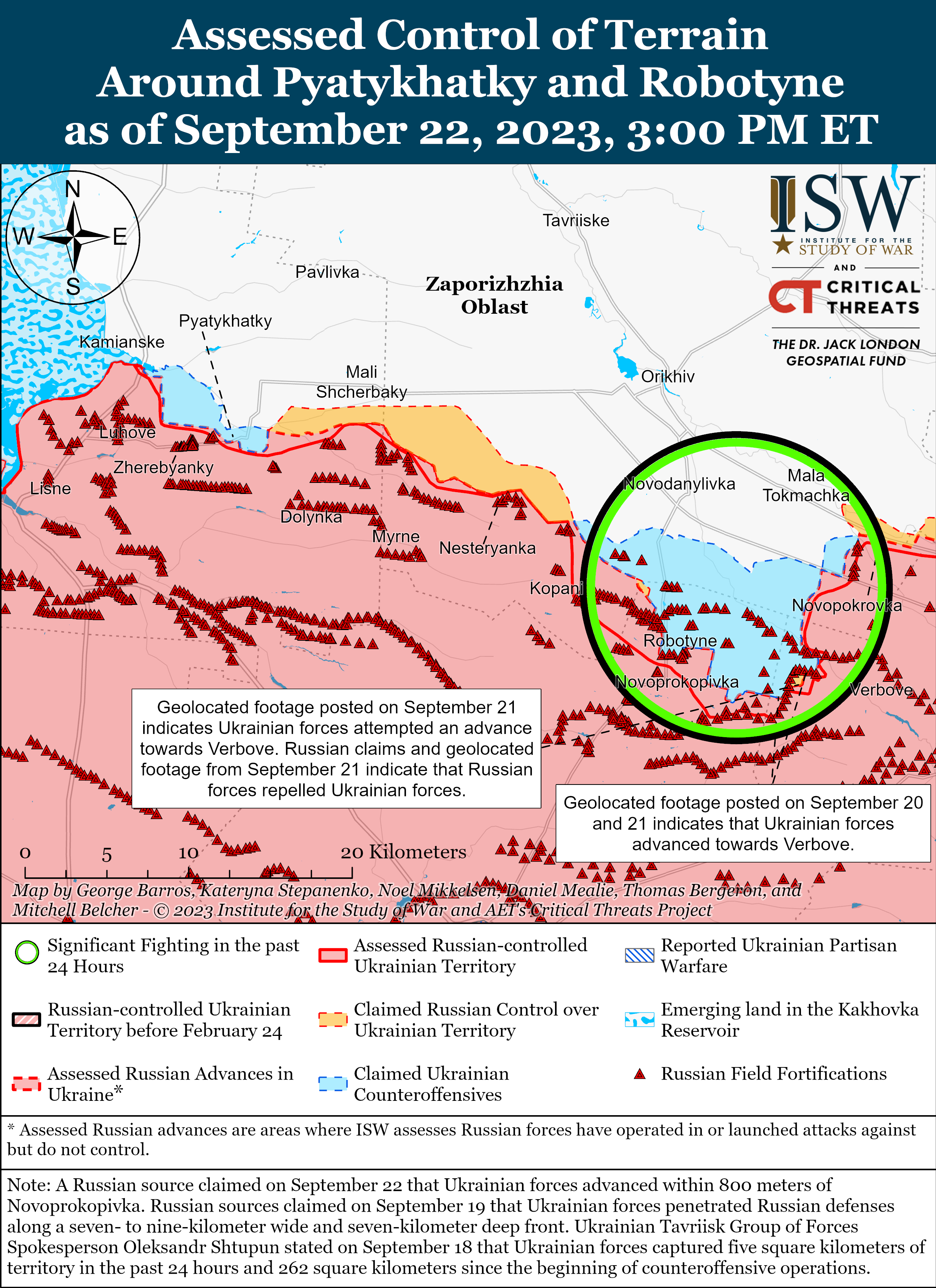
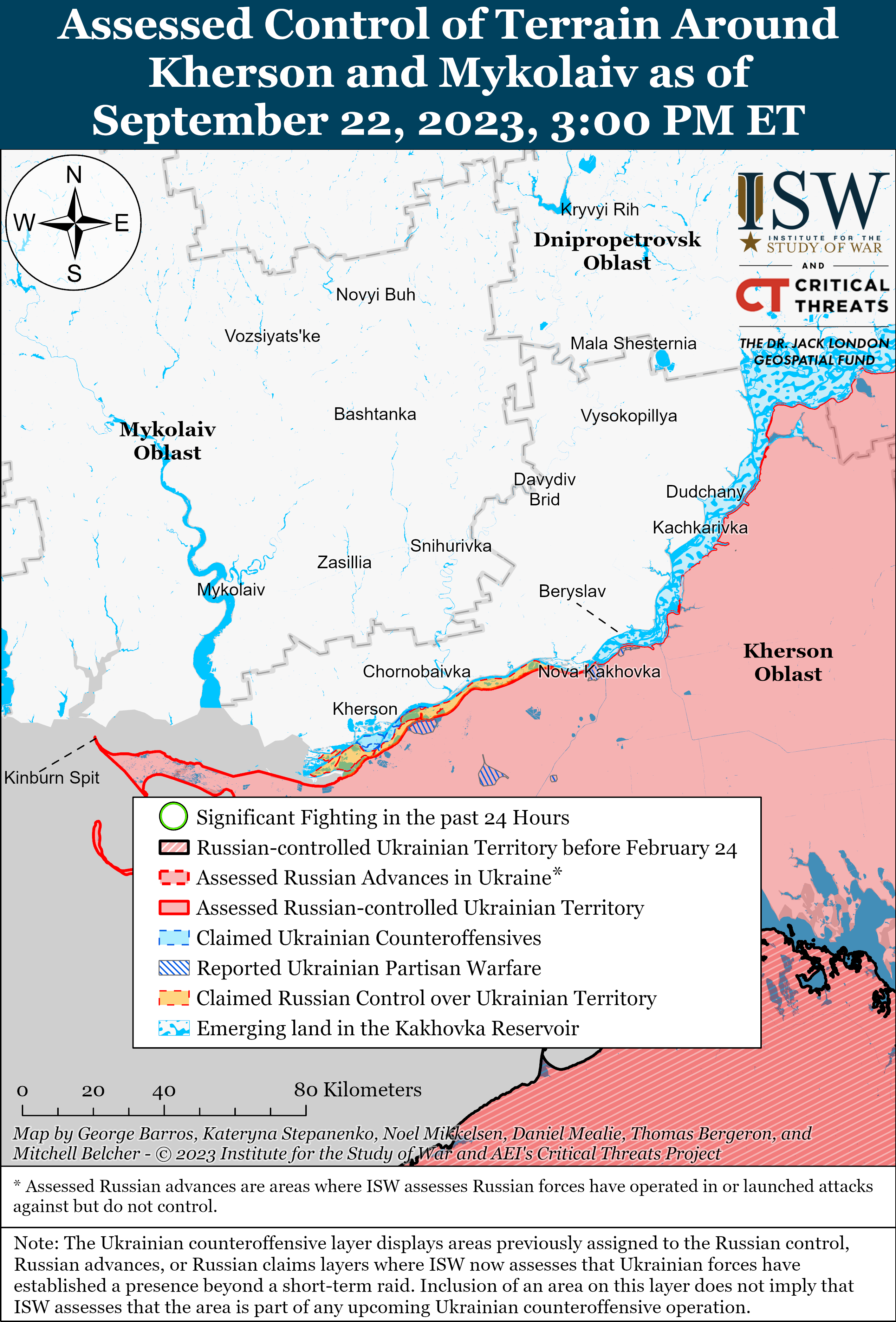
No comments:
Post a Comment